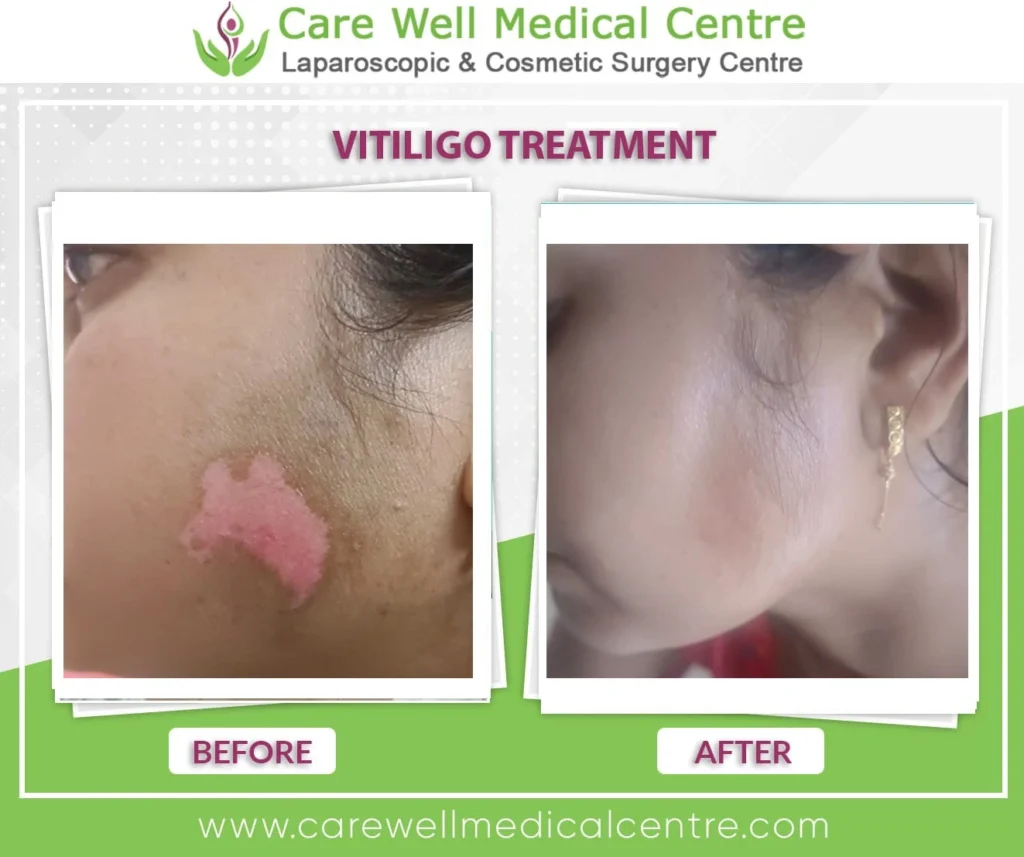
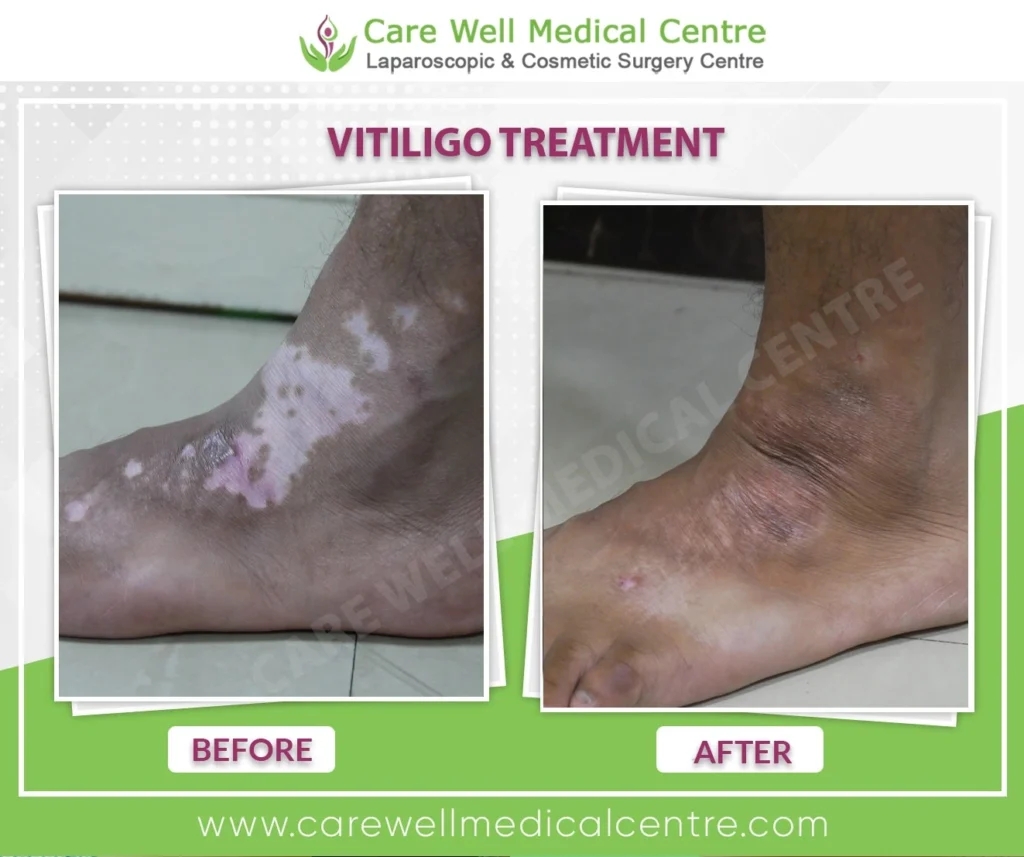
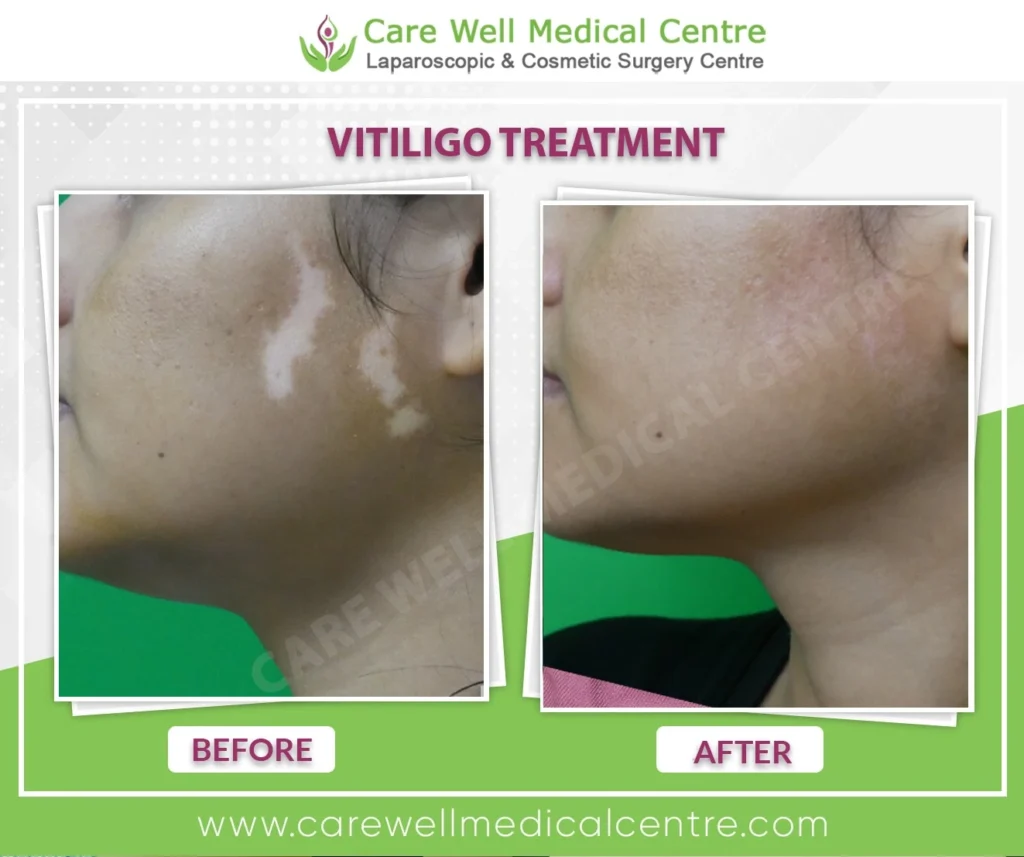
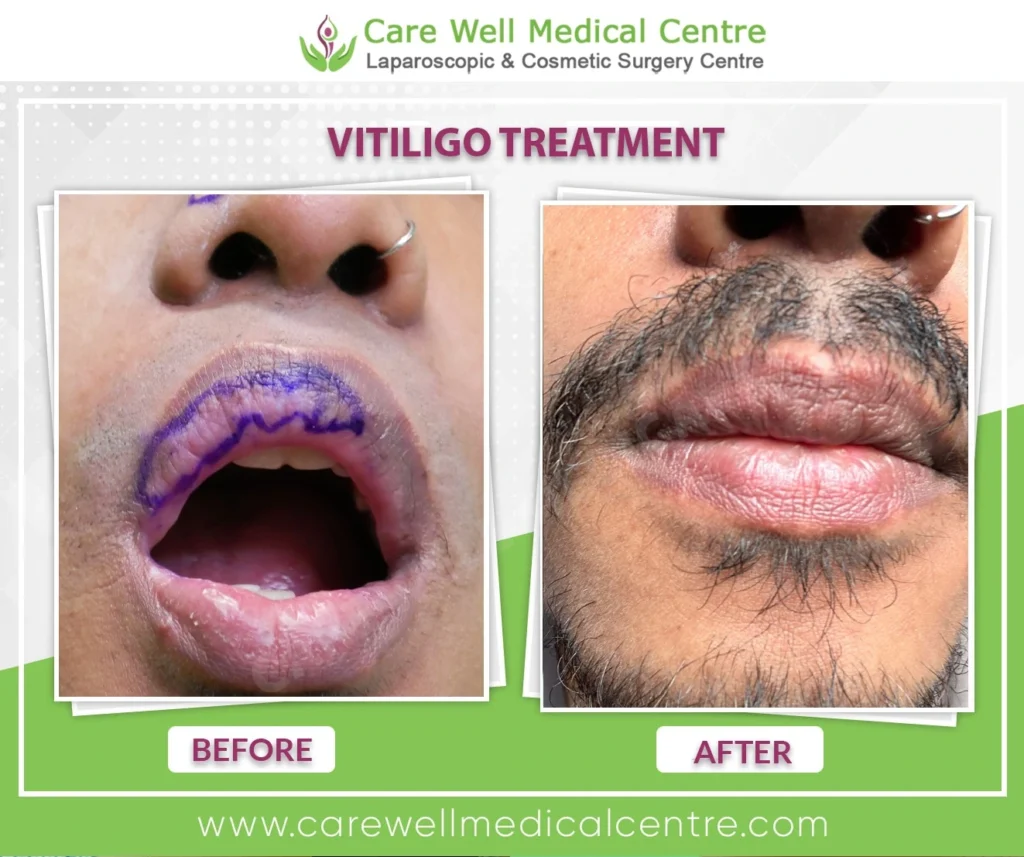
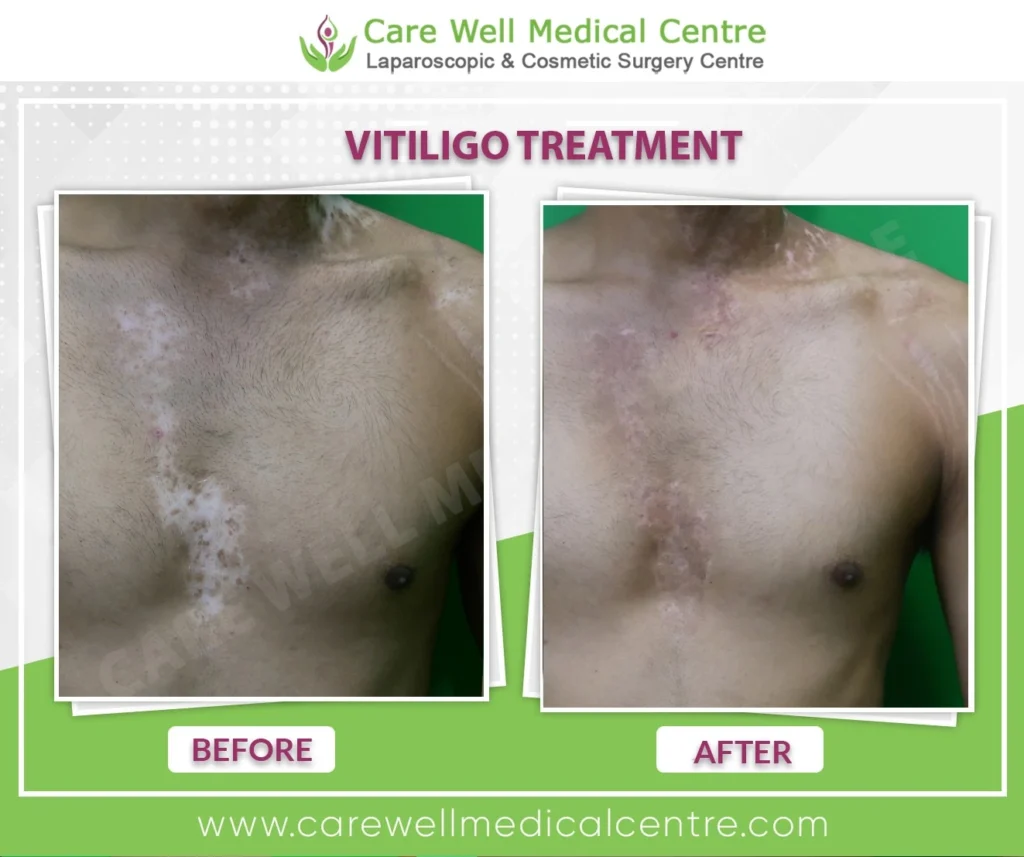
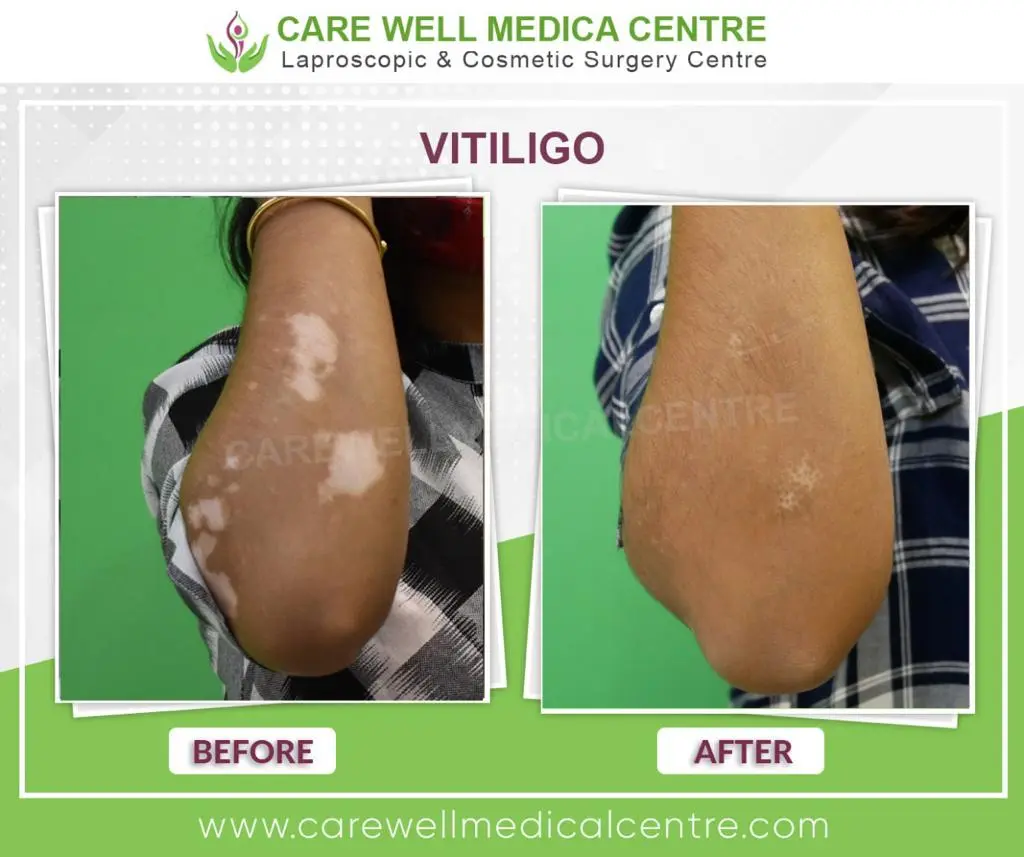
Best Vitiligo/White Patches on Skin Treatment in Delhi
We Offer the Best Cost & Advanced White Patches on Skin/Vitiligo Treatment in Delhi. Care Well Medical Centre offers the latest treatment like Melanocyte Transplantation, Punch Grafting, Skin Grafting & Phototherapy with the best and proven results. Dr. Sandeep Bhasin, an experienced cosmetic surgeon, performs vitiligo treatment with precision and care.
Vitiligo damages melanin, the pigment that gives skin its color. This leads to white patches, often starting on the face. Early treatment can help control its spread. It can happen on any part of the body, and people of all ages, races, and genders can get it. If you are looking for reliable and effective vitiligo treatment in Delhi, then Care Well Medical Centre is the right place to begin your journey.
At Care Well Medical Centre, we offer a comprehensive array of medical, surgical, and cosmetic solutions for vitiligo. Our respected vitiligo doctor in Delhi gives you specialized care that makes your face look better and gives you more confidence. Using modern techniques, we can bring back the beauty of your face. Rely on our expertise to connect you with Delhi’s leading vitiligo specialist and start your journey toward healthier, even-toned skin.
Alright, so let’s get going.
What is Vitiligo (White Patches)?

Vitiligo is a long-term skin problem in which patches of skin lose their color, leaving them white. When melanin-producing cells die, people of all ages, genders, and races can develop vitiligo. As a result, pigment loss becomes visible on the skin.
Vitiligo no longer needs to cause worry. At Care Well Medical Centre, we offer a wide range of treatments to help manage it effectively. Typically, vitiligo appears on the hands, face, and chest. But before we explore how it’s treated, let’s first understand what vitiligo really is.
Melanocyte transplant surgery offers one of the most advanced ways to treat stable vitiligo in India. Within just two to three months, patients often begin to see visible results. Moreover, this technique relies on a completely natural process, which adds to its appeal. In many cases, we also treat short-duration vitiligo effectively when caught early. So, if you’re seeking the best vitiligo treatment in India, this approach provides a reliable option to restore your skin tone and regain confidence.
Explore Our Vitiligo (White Patches) Treatment in Delhi Options:
1. Medical and Phototherapy Treatment
Medical treatment for vitiligo involves the use of topical and oral medications to restore natural skin color. Medications like topical corticosteroids, calcineurin inhibitors, and oral psoralen plus ultraviolet A (PUVA) therapy suppress the immune system and stimulate melanocyte production. Phototherapy exposes the skin to ultraviolet light, stimulating melanocytes and restoring pigment. In some cases, individuals in Delhi, India, may also consider vitiligo surgery in Delhi as a treatment option to address this skin condition.
2. Surgical and Cosmetic Treatment
- Surgical Treatment: Recommended for stable vitiligo, this option includes skin grafting and melanocyte transplants. Skin grafting involves moving normal skin from a donor site to the vitiligo area, while melanocyte transplantation suspends melanocytes to restore pigment production.
- Cosmetic Treatment: This involves techniques like micropigmentation to implant pigment, camouflage makeup to cover patches, and self-tanning products to darken skin and reduce patch visibility.
At Care Well Medical Centre, we prioritize comprehensive vitiligo care, offering effective treatment solutions. If you’re seeking top-notch vitiligo treatment in Delhi, contact us to schedule a consultation.
For more information, read about the innovative Jodhpur Technique for Vitiligo Treatment at Care Well Medical Centre.
👨⚕️ Meet Dr. Sandeep Bhasin – Vitiligo Specialist in Delhi
Dr. Sandeep Bhasin is a senior cosmetic and reconstructive surgeon with over 20 years of experience. Moreover, he brings more than a decade of focused expertise in vitiligo surgeries. At Care Well Medical Centre, he has successfully treated numerous patients. In fact, he uses a combination of modern medical and surgical techniques such as Melanocyte Transplantation, Punch Grafting, and Skin Grafting to deliver lasting results. As a result, patients not only see visible improvement but also regain confidence in their skin.
🎓 Credentials & Training:
- MBBS and MS (General Surgery) – Aligarh Muslim University (AMU).
- Advanced training in pigmentary disorders and vitiligo surgical techniques.
- Experienced in handling complex and stable vitiligo cases across all skin types.
🏆 Highlights:
- Performed 100+ melanocyte and skin grafting procedures.
- Featured speaker at dermatology and cosmetic surgery conferences.
- Renowned for patient-focused care and high repigmentation success rates.
“Treating vitiligo isn’t just about restoring skin color—it’s about restoring confidence. My focus is on giving patients safe, natural-looking, long-lasting results.”
— Dr. Sandeep Bhasin

📞 Book a consultation with Dr. Bhasin today at +91 96679 77499 and take your first step toward confident, clear skin.
Our Vitiligo Treatment Protocol – Step-by-Step
At Care Well Medical Centre, we believe every vitiligo journey is unique. That’s why we’ve designed a structured, personalized treatment approach, built on medical precision and compassionate care. Here’s what you can expect when you choose us.
Step 1: Personalized Diagnosis and Skin Analysis
Your journey begins with a detailed consultation. We examine your skin using specialized tools like Wood’s Lamp to assess the extent and activity of vitiligo. To ensure the right treatment plan, the doctor may first conduct a patch test to check how your skin reacts. This helps us determine if your condition is active or stable — a critical factor for planning effective treatment.
Step 2: Immune Balancing and Preparation
Before moving to any surgical option, our focus is on stabilizing the condition. Through carefully planned oral minipulse therapy and supportive medication like antioxidants and immunosuppressants, we aim to bring your immune system into balance. The doctor begins Narrowband UVB phototherapy during the early phase of treatment. This helps activate melanocytes and prepares your skin for the next steps.
Step 3: Advanced Surgical Options for Stable Cases
If your vitiligo is stable, we may proceed with surgical treatments. Dr. Sandeep Bhasin offers techniques like melanocyte transplantation or skin/punch grafting, depending on the site and type of vitiligo. After preparation, the doctor performs the procedure in a sterile, safe setting. Each step follows a planned approach to achieve visible repigmentation.
Step 4: Aftercare and Pigment Restoration
Post-procedure, we continue with phototherapy to support pigment return. Along with treatment, the doctor may prescribe topical medications to support healing. Follow-up visits help track progress and fine-tune your care plan as needed.
Step 5: Long-Term Care and Maintenance
Our approach doesn’t stop at visible recovery. We offer long-term care that includes nutritional advice, lifestyle adjustments, and counseling if needed. The goal is to protect your results and help you live confidently with healthy, balanced skin.
Want to know which step fits your current stage of vitiligo?
Who is Vitiligo Treatment Ideal For?
Not every case of vitiligo is the same. At Care Well Medical Centre, we recommend personalized treatment options based on the stability and extent of your condition. Here’s who benefits the most from our surgical and non-surgical vitiligo treatments:
Ideal Candidates:
- Adults between 18–50 years of age.
(treatments are safest and most effective in this age group). - Individuals with stable vitiligo.
(no new patches or spreading for at least 6–12 months). - Patients with localized or segmental vitiligo.
(especially on the face, hands, feet, or chest). - Those who are emotionally and mentally prepared for the commitment of a staged treatment and follow-up process.
- People who have not responded well to topical or oral therapies and are seeking longer-lasting pigmentation solutions.
Not Ideal Candidates:
- Individuals with active or rapidly spreading vitiligo.
- Patients with a history of keloid formation or poor wound healing.
- Children under 18 (except under special clinical conditions).
- Those with unrealistic expectations about instant or 100% repigmentation.
- Patients who are unwilling to follow aftercare and phototherapy protocols.
Not sure if vitiligo surgery or medical therapy is right for you? Our expert will guide you personally based on your condition and treatment goals. Book a consultation with Dr. Sandeep Bhasin at +91 96679 77499 to evaluate your skin and treatment suitability.
Vitiligo Myths vs. Facts
There’s a lot of misinformation about vitiligo that causes confusion and fear. At Care Well Medical Centre, we believe in empowering patients with the truth. Here are some of the most common myths — and the facts that debunk them:
| Myth | Fact |
|---|---|
| Vitiligo is contagious. | No, vitiligo is not infectious and cannot be spread through contact. |
| Only dark-skinned people get vitiligo. | Vitiligo affects all skin tones and ethnicities, worldwide. |
| Vitiligo causes pain or itching. | Vitiligo is painless, although some may experience mild irritation. |
| Vitiligo cannot be treated or improved. | Many effective treatments exist, including phototherapy and surgery. |
| It’s caused by poor hygiene or bad habits. | Vitiligo is an autoimmune condition, not related to cleanliness. |
| It can be cured with home remedies alone. | While natural care may support skin health, medical treatment is essential for visible results. |
| Every white patch is vitiligo. | Not always. Diagnosis by a dermatologist is necessary for confirmation. |
Understand Which Body Areas Vitiligo Commonly Affects
Vitiligo is a skin disorder causing white patches. It can occur on any part of the body, especially in sun-exposed areas. Commonly affected areas include hands, elbows, knees, legs, and the face. Vitiligo can also affect mucosal areas such as the lips, rectum, and vagina. In some cases, it impacts the eyes and retina, leading to visible discoloration. Treating vitiligo early helps manage its spread and restore pigment. The loss or destruction of melanocytes causes the condition, affecting the color of your skin, hair, and eyes.
In most cases, vitiligo shows up in these areas first:
- Face and neck: The face and neck are common areas where vitiligo can occur. This can include the lips, around the eyes, and on the forehead.
- Hands and feet: The hands and feet are also common areas where vitiligo can occur. Depigmentation often appears on the fingers, palms, and soles of the feet.
- Genital area: Vitiligo can occur in the genital area, including the penis, scrotum, and vulva.
- Armpits and groin: The areas where the skin rubs against itself, such as the armpits and groin, can be more susceptible to vitiligo.
- Around body openings: Vitiligo can also occur around body openings, such as the mouth, nose, and ears.
- Sun-exposed areas: Sun-exposed areas like the face, hands, and feet tend to develop vitiligo more often.
It’s important to note that vitiligo can occur anywhere on the body, and the extent and location of depigmentation can vary from person to person.
What Causes Loss of Melanin in Vitiligo?
Vitiligo starts when the skin loses its ability to produce melanin, the pigment responsible for natural skin color. This loss occurs after melanocytes, the cells that produce melanin, become damaged or die. Consequently, white patches gradually appear on various parts of the body.
Possible Triggers Behind Melanin Loss:
Researchers believe several factors may trigger this pigment loss:
- Autoimmune reactions where the body attacks its own melanocytes.
- Stress, both emotional and physical.
- Chemical exposure from skin products or environments.
- Neurological factors that disrupt melanin signals.
- Congenital causes, like certain nevi present from birth.
Melanin does not just color your skin — it also helps protect it from UV damage. So when melanin production drops, your skin becomes more vulnerable to sunlight and pigmentation loss.
How Vitiligo Contusions First Appear on the Skin
In the beginning, most contusions happen on the wrists, feet, hands, and face, with a tendency for them to spread around the eyes and mouth. In most cases, vitiligo starts with small, white patches on sun-exposed areas like the wrists, feet, hands, and face. These patches often:
- White patches in oval, round, or linear in shape.
- DE pigmented macules.
- Generally, well-delineated.
- The patches often show outward-curving borders.
- Patch size may vary from millimeters to centimeters.
- Expand divergently over time at an unforeseeable rate.
- These patches don’t hurt or cause Itching.
If you notice such changes, it’s best to consult early. Prompt treatment can help slow progression and restore pigment in many cases.
Types of Vitiligo (White Patches): Clinical Variants
Vitiligo is a skin disease that can show up in many different ways, each with its own symptoms. The various types of clinical variants of Vitiligo include:
- Generalized Vitiligo: This is the most common type of vitiligo. It causes the skin to lose color in a uniform pattern on different parts of the body. The depigmentation may start in one area and spread to other areas over time.
- Segmental Vitiligo: This type of Vitiligo occurs in a unilateral pattern, affecting only one side of the body. It usually develops at an early age and progresses for a few years before stabilizing.
- Focal Vitiligo: This type of vitiligo causes one or a few depigmented spots in a small area.
- Mucosal Vitiligo: This type of Vitiligo affects the mucous membranes of the body, such as the inside of the mouth or nose.
- Universal Vitiligo: This is a rare form of vitiligo where depigmentation occurs over almost the entire body.
- Acrofacial Vitiligo: This type of Vitiligo affects the face, hands, and feet, and may occur in a symmetrical or asymmetrical pattern.
- Mixed Vitiligo: This type of Vitiligo combines features of different types of Vitiligo and is often more challenging to treat.
It’s important to remember that Vitiligo can look different in different people, and some people may have more than one type of it. If you think you might have vitiligo, you should see a vitiligo doctor in Delhi to get a proper evaluation and plan for treatment.
Segmental Vitiligo
The kind of vitiligo that happens in patches gets bigger and spreads more. Doctors recognize it as more even and regular than the non-segmental type, and less unpredictable. This kind of vitiligo is not symmetrical, but it is not very common. Only about 10% of people with vitiligo have this kind.
This usually happens in places on the skin where nerves come out of the dorsal roots of the spine. It reacts well to treatments that are put on the skin. People who are younger are more likely to have a segmental type. About 30% of children with vitiligo have this type.
Non-segmental Vitiligo
Doctors diagnose the most common form of vitiligo in up to 90% of cases and refer to it as non-segmental vitiligo. There are often spots on both sides of the body that are the same, so there is some unity.
Studies link segmental vitiligo, especially when it begins before age 14, to conditions that are harder to treat. It often appears on sun-exposed areas such as the face, neck, arms, and hands.
Non-segmental Vitiligo Sub-Divisions
Experts divide non-segmental vitiligo into several sub-types:
- Generalized: There is no particular part or size of the patches. This is actually the most prevalent type of non-segmental that affects the majority of people with Vitiligo.
- Universal: Depigmentation covers a larger part of the body. This is not very common.
- Acrofacial: This category takes place commonly on the toes or fingers.
- Focal: One, or a few, distributed white patches occur in an unattached area. It is most common in young children.
- Mucosal: This occurs most often around the lips and mucous membranes.
Learn more about treating penile vitiligo by reading our informative article: Discover How Penile Vitiligo Can Be Treated at Care Well Medical Centre!
Vitiligo (White Patches) Management
Vitiligo is a chronic skin condition that can be challenging to manage. While there is no cure for Vitiligo, there are several management options that can help to improve the appearance of the affected skin and prevent further depigmentation. Here are some of the most common management strategies for Vitiligo:
- Topical corticosteroids: Topical corticosteroids are a common treatment for Vitiligo. They work by reducing inflammation and suppressing the immune system, which can help to slow down or stop the depigmentation process.
- Topical calcineurin inhibitors: Topical calcineurin inhibitors, such as tacrolimus and pimecrolimus, are another type of medication that can be used to treat Vitiligo. They work by modulating the immune system and can be effective in reducing inflammation and promoting repigmentation.
- Phototherapy: Phototherapy involves exposing the skin to UV light, either in a clinic or at home, to stimulate melanocyte production and promote repigmentation. There are several types of phototherapy available, including narrowband UVB and PUVA.
- Excimer laser: Excimer laser therapy uses a specialized laser to target depigmented areas of the skin and stimulate melanocyte production. This can be an effective treatment option for localized areas of Vitiligo.
- Skin grafting: Skin grafting involves transplanting healthy skin from one area of the body to the affected area. This can be an effective treatment option for stable, localized areas of Vitiligo.
- Camouflage makeup: Camouflage makeup can be used to cover up depigmented areas of the skin and improve the appearance of Vitiligo.
Treatment effectiveness varies between individuals, requiring a personalized plan and collaboration with a dermatologist.
Our Common Protocols for Vitiligo Management are as follows:
- Oral Minipulse therapy with Corticosteroids. We give Oral Betamethasone twice a week in a mini pulse dose to reduce side effects. Usually, this stabilizes the Vitiligo in 3- 4 months.
- We often add another Immunosuppressant Azothiaprim to the above, A strict monitoring of LFT and other parameters is a must.
- We give oral antioxidants, Multivitamins, Polypodium Leucotomies, Phenyl Alanine, etc. as adjuvant therapies.
- Ozone Major AutoHaemotherapy where we mix ozone gas in 200 ccs of the Patient’s blood and transfused it back. This is helpful in immune balancing.
- Regular Use of Narrow Band UVB Chambers thrice a week. This helps to stabilize Vitiligo and helps in faster repigmentation of patches. This also reduces the dose of Steroids.
- Topical Steroids, Calcineurin Inhibitors, Pseudo catalase inhibitors, and methoxy psoralen. All these help in faster repigmentation.
- Meyers Protocol where we give intravenous drips of Multivitamins to accelerate pigmentation.
With our exhaustive protocol, we find that our success rate goes much higher than using standard protocols that don’t focus on immune balancing, nutrition, and other aspects of treatment that we focus upon.
During therapy, pigment cells surface up and escalate from the pilosebaceous unit, relieve epidermal melanocytes, and the outline of lesions or contusions, and migrate up to 2-4 mm from the edge.
Tattooing in Vitiligo (White Patches)
Tattooing can help enhance the look of depigmented areas in individuals with Vitiligo. It involves injecting pigment into the skin to create a lasting, natural-looking color match. This process, known as micropigmentation, utilizes tiny needles to deposit customized pigments that match the patient’s skin tone. It can be performed on small or large body areas.
- Lack of precision: Tattooing can be imprecise, and the color of the tattoo may not match the surrounding skin exactly. This can result in an unnatural or uneven appearance.
- Fading: Over time, tattoos can fade and change color. This can be particularly problematic in areas of the skin that are exposed to the sun or subjected to frequent friction, such as the hands or feet.
- Allergic reactions: Some people may have allergic reactions to the pigments used in tattoos. This can result in itching, swelling, or other skin reactions.
- Pain: Tattooing can be painful, particularly in areas of the body that are sensitive or have thin skin.
- Risk of infection: Tattooing carries a risk of infection, particularly if proper hygiene practices are not followed. Infections can lead to scarring or other complications.
Dermatologists often do not recommend tattooing for vitiligo. Topical treatments or phototherapy may be more effective and safer. Consult a healthcare provider to determine the best treatment for your case.
Potential Future Vitiligo Treatments (White Patches)
Treatments being studied include:
Soon, it won’t be surprising to see the most effective medical treatments that can fix vitiligo and other skin diseases.
- A drug that reverses color loss in the skin: An oral drug called Tofacitinib Citrate, mainly used to treat rheumatoid arthritis, has some potential as a treatment for vitiligo. It blocks an enzyme called Janus kinase that seems suspicious in the cytology of vitiligo.
- A drug that recovers color loss in the skin: This novel drug, pseudocatalase, may treat vitiligo’s skin color loss. Researchers released this drug’s 2013 data, which included some subjects receiving a modified pseudo-catalase. PC-KUS recovered skin and eyelash pigmentation. Additionally, the chemical restored natural hair color in gray-haired people.
- A drug to provoke color-producing cells (melanocytes): To encourage melanocyte formation, afamelanotide, a synthetic chemical that mimics alpha-MSH, is placed under the skin. Low melanocyte-stimulating hormone in vitiligo may be the cause of low melanin levels. Afamelanotide, combined with UVB therapy, is also beneficial.
- A drug that helps control melanocytes: Researchers apply Prostaglandin E2 as a cream on the face to help restore skin color in people with stable, localized vitiligo.
As a way to find, avoid, and treat this disease, doctors are looking into and trying possible new treatments, procedures, and tests.
Home Remedies For Vitiligo (White Patches)
Even though there is no fix for vitiligo, there are some things you can do at home to help with the symptoms. You can use these cures along with the medical treatments that a dermatologist or other trained healthcare provider has told you to do. Before trying any home cures for vitiligo, you should talk to a doctor or nurse. Some natural remedies may interact with recommended drugs or make the disease worse. The following self-care strategies may help to cope with Vitiligo by reducing its appearance and improving your skin:
Protecting Your Skin:
- Shield skin from the sun and UV light.
- Use broad-spectrum SPF30 sunscreen on light skin with Vitiligo.
- Reapply sunscreen during movement, sweat, or swimming.
- Avoid sunlamps, halogen bulbs, and tanning beds.
- Seek shade and wear protective clothing.
- Refrain from tattooing to prevent new patches.
- Concealers and makeup can reduce visibility.
Natural Remedies:
- Aloe vera reduces redness and itching.
- Turmeric’s curcumin has antioxidant properties.
- Mix turmeric with mustard oil for affected skin.
- Ginger’s anti-inflammatory effects can help.
- Mix ginger juice with red clay for application.
- Neem’s antibacterial properties reduce itching.
- Crush neem leaves for a soothing paste.
- Ginkgo biloba is studied for vitiligo treatment.
- Follow the healthcare provider’s guidance for ginkgo biloba.
- Coconut oil improves skin health and reduces inflammation.
Home remedies aren’t a substitute for medical treatment. Consult a dermatologist for personalized treatment. Use dyes to cover white spots. Self-tanners with dihydroxyacetone are FDA-approved but fade gradually.
Understanding Vitiligo (White Patches) Treatment Cost in Delhi, India
When thinking about how to treat vitiligo in Delhi, it’s important to know how much vitiligo treatment cost in Delhi. The size of the damaged area can change how much it costs for vitiligo surgery in Delhi. For example, the average cost of vitiligo treatment in Delhi for a 1-cm spot is around 65,000 INR. It’s important to know that the cost of treating vitiligo in Delhi, India, is less than in many other places. If you need a lot of care, it could cost up to 2,00,000 INR. Talking to doctors or hospitals in Delhi that treat vitiligo is the best way to get a price for your specific case.
Cost of Vitiligo Treatment in Delhi
At Care Well Medical Centre, we offer personalized vitiligo treatments based on your condition and the chosen technique. Below is an estimated cost range for each procedure:
| Treatment Type | Estimated Cost (INR) |
|---|---|
| Melanocyte Transplantation | ₹65,000 per session |
| Skin Grafting | ₹45,000 – ₹85,000 |
| Punch Grafting | ₹30,000 – ₹60,000 |
| NB-UVB Phototherapy | ₹800 – ₹1,200 per session |
| Topical/Oral Medications | ₹1,500 – ₹5,000 per month |
| Consultation with Dr. Bhasin | ₹1,000 |
Notes:
- Final pricing depends on the size of the affected area, treatment sessions required, and combination therapies.
- Discounts on package treatments and EMI options may be available.
- During your consultation, a personalized quote will be provided.
📞 For a cost estimate based on your condition, call us at +91 96679 77499.
We will guide you through the most effective and affordable treatment path.
Why Choose Care Well Medical Centre for Vitiligo Treatment in Delhi?
If you are searching for the best vitiligo treatment in Delhi, Care Well Medical Centre is the ideal choice. Our team of experienced dermatologists or cosmetic surgeons, including Dr. Sandeep Bhasin (Sr. Cosmetic Surgeon), provides personalized and effective treatment plans tailored to the individual needs of each patient. We use the latest techniques and equipment to offer safe and effective treatments, including phototherapy, topical medications, oral medications, and surgical procedures. Dr. Sandeep Bhasin leads our vitiligo care in Delhi, delivering exceptional treatment and visible results.
Our goal is to restore pigment to the skin and help our patients feel more confident in their appearance. Additionally, we provide counseling and support to help our patients cope with the emotional impact of vitiligo. Contact Care Well Medical Centre today to schedule a consultation and take the first step towards clearer, healthier skin.
Vitiligo Treatment Before and After Results
See how our patients have experienced real, visible transformations through advanced vitiligo treatments at Care Well Medical Centre. Whether it’s Melanocyte Transplantation, Skin Grafting, or Phototherapy, our results speak for themselves.




📝 Note:
- Results vary based on individual condition and stability of vitiligo.
- All images used with patient consent for educational purposes.
📞 Want to know what treatment suits your case?
Call us now at +91 96679 77499 to book your personalized consultation.
Vitiligo (White Patches) Treatment Video
Hear What Our Patients Say About Their Vitiligo Journey
At Care Well Medical Centre, every success story inspires us to do more. Whether it’s Melanocyte Transplant, Skin Grafting, or NB-UVB Phototherapy, our patients have experienced life-changing improvements — and they are sharing their journeys with you.
How to Reach Care Well Medical Centre for Vitiligo Treatment in Delhi
Clinic Address:
Care Well Medical Centre
House No. 1, NRI Complex, Chittaranjan Park,
Near Mandakini Enclave & Alaknanda Market,
New Delhi, Delhi – 110019
We’re centrally located in South Delhi — easily accessible from all major parts of the city.
- 🚇 Nearest Metro Station: Govindpuri (Violet Line) – 8 minutes away
- 🚗 Parking: Free street parking is available
- 🛺 Landmark: Opposite NRI Apartments, close to Mandakini Enclave and Alaknanda
📞 For assistance with directions, call: +91-9667977499
Vitiligo Treatment FAQs
There is no best treatment for vitiligo since it depends upon the affected area, how quickly the depigmentation spreads, the patient’s age, etc. For early-stage treatments, medicines like vitiligo creams may help, but light therapies such as phototherapy and surgeries may be the only suitable options for later stages.
No, vitiligo cannot be cured permanently. The vitiligo treatments available focus on how to stop the spreading of depigmentation from one part to the next and treat the existing discolored areas. Since there is no cure, learning how to manage the condition can be of great help.
About 30% of vitiligo cases are reported to have genetic causes. It is caused by a lack of a body pigment known as melanin. Melanocytes produce melanin. In vitiligo, individuals lack melanocytes that are responsible for producing skin pigment.
Vitiligo can affect individuals of all backgrounds and skin tones, and it affects all ethnicities nearly evenly. Anyone with a chance of developing the skin disease develops it before age 20. More than half of the affected individuals get vitiligo as children.
No, vitiligo cannot be cured naturally. It is a skin disease that has yet to have a permanent remedy. Individuals with vitiligo may learn how to manage it naturally through a good and healthy lifestyle, but as of now, there is no cure available.
Sunlight could be good or bad for people with vitiligo. The affected individuals lack melanin, a body pigment that is known to protect the skin from harmful sun rays. Due to this, some technicians believe that sunlight may harm patients. On the other hand, light therapy is used as a vitiligo skin disease treatment.
No, the natural process of vitiligo cannot be stopped. After the occurrence, a technician can help treat the affected discolored areas with drugs or light therapy but cannot help with the disruption of naturally occurring vitiligo.
There has been no relevant research to link eggs with vitiligo. It is best to ask your technician whether eggs will slow down the leukoderma treatment. The ayurvedic text suggests avoiding eggs altogether, but since no medical research backs it up, this domain remains a mystery.
To increase melanin, it is best to consume a diet that is rich in antioxidants. Include foods such as citrus, berries, leafy green vegetables, etc. If you are someone who has trouble consuming a restricted diet, you can opt for supplements to ease it.
There has been no relevant research to link eggs with vitiligo. It is best to ask your technician whether eggs will slow down the leukoderma treatment. The ayurvedic text suggests avoiding eggs altogether, but since no medical research backs it up, this domain remains a mystery.
Melanin production can be increased naturally through consuming a healthy vitamin-rich diet. Consuming vitamins C, E and F have been known to positively affect vitiligo. Doctors usually recommend artificial ways such as medications or light therapies to increase melanin production in the body.
The FDA has recently approved ruxolitinib cream sold under the brand name Opzelura. Until recently, the treatment for vitiligo was limited to light therapies and oral medication. A vitiligo treatment cream helps to calm the patient’s immune system and produce normal melanocytes. This new treatment is the latest to be found.
Yes, Ayurveda claims to cure vitiligo. The leukoderma treatment they offer consists of Vamana, Virechana, and Basti therapy. In Ayurveda, vitiligo is known as a ‘Tridosha disease’. Ayurveda focuses on strengthening the immune system using the mentioned therapies.
To manage vitiligo on an everyday basis, it is important to know what to avoid. Excessive sun exposure, burns, cuts, usage of a sun lamp or tanning lamp, and getting tattoos should all be avoided. Contact your Vitiligo best doctor in Delhi to know the detailed measures to take to manage the skin disease.
In some cases, it has been observed that certain skin patches have disappeared over time. Vitiligo does not have a cure; thus, to make the skin patches seem less prominent, doctors advise light therapies, oral medication, or creams. The disease has a very low chance of disappearing by itself.
Studies show that Ginkgo biloba can help treat vitiligo. Researchers extract compounds from the plant and process them into tablets. Patients typically take these tablets 1 to 3 times a day for up to three months to notice improvement.
The FDA recently approved the use of ruxolitinib cream for vitiligo patients. Other ointments may include calcineurin inhibitors, such as tacrolimus or pimecrolimus. Creams have recently been validated for use by vitiligo patients; thus, patients are still sceptical of their use.
Oils are not a medical intervention but more of a home remedy used to tackle vitiligo. Mustard oil, black cumin oil, black seed oil, tolenorm oil, etc. are all known to increase melanin production and bring pigment to discoloured patches.
No, coconut oil cannot remove the white patches that occur in vitiligo patients. Coconut oil works as an anti-inflammatory agent; it helps to calm the skin down and provide moisturization without any evident irritation. It can be used as an everyday moisturizer, but it is not a treatment option for vitiligo.
Yes, vitiligo may spread with stress. The hormones that respond to psychological or environmental stress have been found to have higher levels in vitiligo patients. Cortisol, catecholamines, neuropeptides, etc. all respond to stress and play a significant role in the development of the disease.
There is no standard age at which vitiligo stops spreading. Although studies suggest that anywhere between 6 months to 2 years post-onset, the progression stops, It spreads fast but stops after a certain time period.
Vitiligo does not have a permanent cure; thus, treatment may only be temporarily reliable. Unfortunately, there is a high chance of vitiligo coming back after treatment due to the lack of a permanent remedy.
Vitiligo patients should protect their skin by avoiding direct sunlight, preventing injuries, skipping permanent tattoos, and limiting exposure to sunlamps.
Vitiligo patients can suffer other problems such as psychological stress, hearing issues, visual impairments, sunburns, overly sensitive skin, etc. Along with having evident skin discolouration or white patches in segmental or non-segmental forms.
Vitiligo spreads rather quickly. It takes anywhere from 6 to 24 months for the disease to spread to significant body parts. The natural process of vitiligo distribution cannot be stopped, although your doctor may suggest ways to pigment the discoloured areas later.
Vitiligo can occur on any part of the body but the majority of affected individuals get the white patches on their face, hands, neck, genitals, armpits, inside of the mouth, etc.
Vitiligo surgery in Delhi, NCR, can cost anywhere between Rs. 20000 and Rs. 50000. The cost of vitiligo surgery in Delhi depends upon the affected area, the qualifications of the technician, the type of surgery performed, etc.
Yes, Care Well Medical Center is an excellent clinic to consider for vitiligo treatment in Delhi. The medical centre has a good standardized rating of 4.1 on google which showcases the skills of medical technicians working at the facility.
Care Well Medical Centre is the best clinic for vitiligo treatment in Delhi, NCR, because the practitioners are highly qualified and skilled and provide a patient-focused treatment. All the procedures are carried out in accordance with the patient’s requirements.
